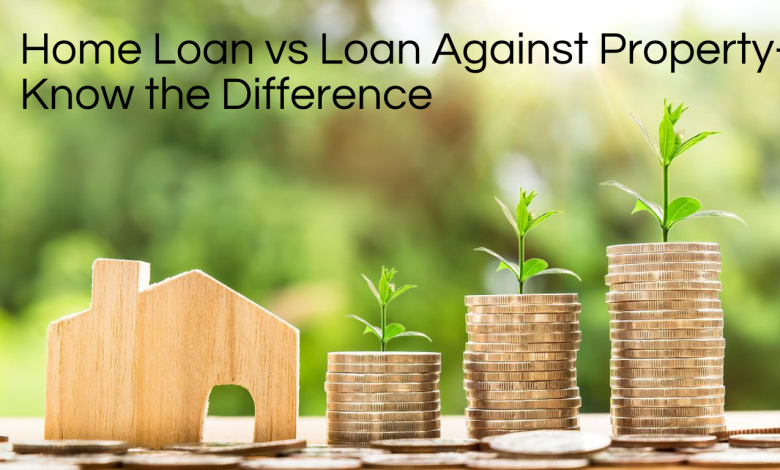Home Loan vs Loan Against Property- Know the Difference

People choose to apply for loans in order to cover any financial need or emergency. Despite the fact that banks and other financial institutions offer a variety of credit options to suit various life events, some people could be confused by two loan concepts that appear to be similar but aren’t. These are home loans and loans against property. Knowing the various credit kinds can help you understand the stark contrast between a home loan and a loan secured by real estate. Although a home loan and a loan against property are two separate kinds of loans, the phrases used to describe them sometimes cause people to become confused.
We provide you with all the information you need to understand the distinctions between home loans and loans against property.
Purpose of the loans
A home loan is used to finance a home that you want to buy, build, or buy a piece of land, whilst a loan against property is used to finance an existing property. In other words, the borrower borrows money against the property, which is mortgaged to the lender.
A home loan has a specific purpose and can only be used for that purpose, which is to purchase a new property. However, the final purpose of the loan against the property is undefined. Similar to a personal loan, it can be used for a variety of things, including starting or growing a business, financing education, covering unexpected medical expenditures, paying for a wedding, etc.
It is possible to use a loan against property to finance either a commercial or a residential property. One may use real estate as collateral for a lump sum loan or even as a line of credit for a predetermined period of time.
Interest rate
Home loans are under priority sector lending, and because they are secured loans backed by real estate, their interest rates range from 8.5 to 12%, depending on the lenders and the borrower’s credit history. Home loans are based on a lending rate with a marginal cost of funds component (MCLR).
However, due to the open-ended nature of the loan, loans against property are not regarded as a priority sector. As a result, the interest rate charged is higher than for home loans. Depending on the lenders, the property being mortgaged, and the credit profile, the interest rate is currently between 10 and 15 percent.
However, the interest rate on a loan secured by property is lower than the interest rate on an unsecured loan like a personal loan.
Tenure of the loan
Lenders now provide home loans with terms up to 30 years long. But loans against property are not permitted for such lengthy terms. The maximum loan term available is 15 years, however this can change depending on a number of criteria, including the borrower’s credit history, the age and condition of the property up for mortgage, the amount of the loan being taken out, etc.
Loan to value ratio
Every loan has a margin payment requirement from the borrower’s side as a demonstration of their commitment to the loan. The same applies to both home loans and loans against property. Both call for a specific margin payment. The margin amount also shields the lenders from a decline in the property’s market value.
The minimum proportion of margin money that must be obtained from the borrower in the case of home loans is outlined in RBI regulations for bankers. The maximum percentage of the loan amount that is permitted is 90%, thus the borrower will be required to provide the remaining 10%. For big-ticket loans or when it comes to people with bad credit, this number might even go up to 25%.
The margin criteria for housing finance companies are outlined similarly by National Housing Bank, and they are nearly identical to those outlined by RBI.
The margin requirement is larger for loans against property nevertheless, as this type of lending is not considered to be in the priority sector. Therefore, the required margin may be between 24 and 40 percent of the property’s worth.
Documentation
Since both loans are based on real estate or other immovable property, there is clearly a significant amount of documentation required. In contrast, a home loan has a shorter approval procedure and involves fewer paperwork, particularly when purchasing from a reputable developer or if the project has already been approved.
However, depending on the type of property being mortgaged, the number of documents needed when applying for a loan against a property may be significantly higher. The title to the property and any encumbrances, if any, will need to be thoroughly investigated by the lender. If the property is owned jointly, all of the owners must agree. There may be future disagreements if the property was inherited or left in a will. The approval procedure for a loan against property may take longer than a home loan because several legal difficulties may be involved.
Tax exemptions
The possibility of tax exemption may be the most significant distinction between the two loans. Home loans come with tax benefits under Section 24 for the interest paid on them and under Section 80C for the actual principle amount, whereas loans against property typically do not.
Your needs will determine whether you choose a home loan or a loan against property. You might choose a Loan Against Property against a Home Loan if you need money for any reason. When you need a large loan and want to pay less interest than a personal loan, a loan against property might be a smart choice. You must, however, keep in mind that you risk losing your property if you are unable to repay the loan on time.




